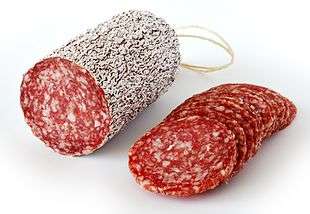Lunch meat
|
A tray of assorted lunch meats | |
| Alternative names | Cold cuts, luncheon meats, sandwich meats, cooked meats, sliced meats, cold meats, deli meats |
|---|---|
| Main ingredients | Meat and/or cheese |
|
| |
Lunch meats—also known as cold cuts, luncheon meats, Colton, cooked meats, sliced meats, cold meats, smallgoods and deli meats—are precooked or cured meat, often sausages or meat loaves, that are sliced and served cold or hot on sandwiches or on party trays.[1] They can be bought pre-sliced in vacuum packs at a supermarket or grocery store, or they can be purchased at a delicatessen or deli counter, where they might be sliced to order.
Health
The World Cancer Research Fund International guidelines on cancer prevention state avoiding all processed meats.[2]
Most pre-sliced lunch meats are higher in fat, nitrates, and sodium than those that are sliced to order, as a larger exposed surface requires stronger preservatives.[1] As a result, processed meats significantly contribute to incidence of heart disease and diabetes, even more so than red meat.[3]
A prospective study following 448,568 people across Europe showed a positive association between processed meat consumption and mortality, due to cardiovascular diseases and cancer.[4] Similarly, a prospective study in United States following half a million people concluded a similar association with death and increased processed meat consumption.[5]
Safety
The US Centers for Disease Control and Prevention advises that those over 50 reheat lunch meats to "steaming hot" 165 °F (74 °C) and use them within four days.[6]
Regional differences
Commonwealth countries
In Commonwealth countries, luncheon meat specifically refers to products that can include mechanically reclaimed meat and offal. In these countries, the terms cold meats, cooked meats, deli meats or sliced meats are used instead.
Latin America
The Spanish word for lunch meat, fiambre, is also used in street slang to refer to a dead body (more common in Chile and Argentina), because of the word used to express low temperatures of the bodies. In Brazil, the Portuguese for ham, presunto, is also used with the same meaning.
In Guatemala, a lunch meat is a traditional dish eaten in November. It is eaten the first and second day of the month to celebrate "El día de Todos los Santos" (All Saints' Day) and "El día de Todos los Difuntos" (All Souls' Day). There are two types: red and white.
Types
- Bresaola
- Chicken breast
- Chicken loaf (also known as chicken roll)
- Corned beef
- Cotechino
- Dutch Loaf
- Ham
- Baked
- Boiled
- Chipped chopped
- Cooked
- Éisleker
- Jamón: serrano or ibérico
- Prosciutto
- Smoked
- Head cheese
- Meatloaf
- Ham & cheese loaf
- Olive loaf
- Pepper loaf
- Pimento loaf
- Spiced luncheon loaf
- Veal loaf
- Mortadella
- Pork roll
- Roast beef
- Roast pork

- Salami
- Alpino
- Capicola
- Finocchiona
- Italian-style
- Jewish-style
- Pepperoni
- Soppressata
- Sausages
- Bierwurst or beerwurst
- Blood tongue (Zungenwurst)
- Bologna, Polony
- Braunschweiger
- Chorizo
- Devon
- Gelbwurst
- Jagdwurst
- Krakowska (Kraków-style pork sausage)
- Liverwurst
- Prasky
- Saucisson sec (dry, maturing, salty, savoury-tasting French salami)
- Summer sausage
- Thuringian sausage
- Teewurst
- Smoked meat
- Tongue
- Turkey breast
See also
References
- 1 2 Phil Lempert (27 December 2006). "The 5 things you need to know about deli meats". Today Food. NBC News. Retrieved 17 March 2013.
- ↑ "Animal foods | World Cancer Research Fund International". wcrf.org. Retrieved 2015-12-17.
- ↑ Micha, Renata; Michas, Georgios; Mozaffarian, Dariush (2012-12-01). "Unprocessed red and processed meats and risk of coronary artery disease and type 2 diabetes--an updated review of the evidence". Current Atherosclerosis Reports. 14 (6): 515–524. doi:10.1007/s11883-012-0282-8. ISSN 1534-6242. PMC 3483430
 . PMID 23001745.
. PMID 23001745. - ↑ Rohrmann, Sabine; Overvad, Kim; Bueno-de-Mesquita, H. Bas; Jakobsen, Marianne U.; Egeberg, Rikke; Tjønneland, Anne; Nailler, Laura; Boutron-Ruault, Marie-Christine; Clavel-Chapelon, Françoise (2013-01-01). "Meat consumption and mortality--results from the European Prospective Investigation into Cancer and Nutrition". BMC medicine. 11: 63. doi:10.1186/1741-7015-11-63. ISSN 1741-7015. PMC 3599112
 . PMID 23497300.
. PMID 23497300. - ↑ Sinha, Rashmi; Cross, Amanda J.; Graubard, Barry I.; Leitzmann, Michael F.; Schatzkin, Arthur (2009-03-23). "Meat intake and mortality: a prospective study of over half a million people". Archives of Internal Medicine. 169 (6): 562–571. doi:10.1001/archinternmed.2009.6. ISSN 1538-3679. PMC 2803089
 . PMID 19307518.
. PMID 19307518. - ↑ "CDC: Over 50? Heat cold cuts to 165 degrees to avoid listeria". USATODAY.com.
External links
 Media related to Cold cut at Wikimedia Commons
Media related to Cold cut at Wikimedia Commons

